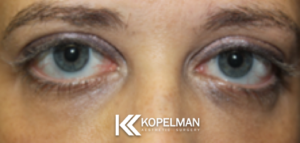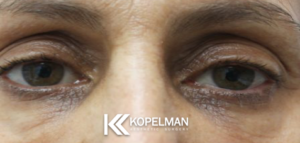Dark circles of the lower eyelids can affect people of all ages and ethnicities. Hollow eyes give an impression that the person is tired, fatigued and sometimes older than their stated age even though the person feels fully rested.
Dark circles can be a troubling cosmetic feature that cannot be easily camouflaged. The most common causes for dark circles under the eye are due to loss of facial fat, thinning of lower eyelid skin that reveals underlying blood vessels and increased pigmentation.




These dark eyelid before and after pictures represent actual patients from Dr. Kopelman. They will help you to set realistic goals for your own surgical outcome. Click on a patient to learn more about their tear trough treatment.
“Dark Circles under my eyes had been bothering me for a long time. I found Dr. Kopelman on the Internet and I had been very impressed by all the positive reviews he had received. The doctor was great, and ultimately I was able to decrease the presence of dark rings around my eyes thanks to his experience and soft touch with injections and a laser resurfacing treatment. ”
~ Sunni K. ~
During your consultation Dr. Kopelman will analyze the underlying causes for your dark circles. It is not uncommon for him to encounter patients who have a combination of increased skin pigmentation and volume loss. If your dark circle problem is due to loss of facial fat then an under eyelid filler injected into inner corner “tear troughs” of the eyelids is the simplest way to correct the hollows associated with dark circles. There are many injectable filler options available but some of these fillers are better than others for filling under eye hollows.
Safety is Dr. Kopelman’s primary concern. Injections around the eyelids is generally very safe and that safety can be increased with the proper techniques and selecting the best injectable products. Dr. Kopelman chooses injectables that have an excellent safety record, a very low risk of an allergic reaction, a therapeutic benefit for more than one year, and an ability to be reversed if the cosmetic effect is not what you want. He typically recommends non-animal derived hyaluronic acid gel (abbreviated “HA”) fillers because they have a high safety profile and a very low risk of an allergic reactions. As a expert injector, Dr. Kopelman believes that Restylane is the best injectable filler for lower eyelid tear troughs because it is cross-linked for greater longevity and a decreased risk for prolonged swelling compared to Juvederm products. Occasionally some patients consult Dr. Kopelman after they have received too much filler from other doctors that resulted in a lumpy and bluish tone of the under eyelid skin. In these cases you do not have to live with these results because in most cases Restylane is easily dissolved in minutes with an enzyme called hyaluronidase.
Dr. Kopelman does not recommend more permanent fillers like Radiesse, Sculptra, Belafill or silicone because they may look lumpy, you may feel the permanent filler beneath your skin and most importantly these products cannot be reversed with hyaluronidase.
Dr. Kopelman removes any make-up, sterilizes the lower eyelid with antiseptics and applies lidocaine cream to the area. After ten minutes he injects a small amount of lidocaine (like novacaine) into the skin which numbs the area and produces constriction of capillaries. Next, Dr. Kopelman will use a blunt tipped cannula (not sharp needles) to inject filler into eyelid hollows. The reason is that sharp needle injections have been associated with HA emboli injected into blood vessels that rarely can lead to blindness. Blunt cannulas are safer instruments because they tend to “roll-off” the blood vessels rather than penetrating the wall of a vessel. Cannulas also produce much less bruising. Small amounts of filler are used. The procedure takes approximately 30 minutes. Minimal bruising will be expected.
HA fillers mentioned above are not permanent and therefore require repeat injections approximately every year to maintain the cosmetic improvement. Fat is an option that has the potential to last longer. It is obtained from your own belly fat or hip with a minor surgical procedure. Fat that is harvested is centrifuged and injected into lower eyelid hollows. Fat as a filler has the potential to last longer than synthetic fillers. Therefore. some patients who are seeking longer lasting benefits will request fat grafts. Dr. Kopelman performs this procedure on select patients. However, fat grafts can be unpredictable because live fat cells require a good blood supply and only very small amounts of fat can be injected at one time. Repeat grafts are sometimes necessary to obtain an ideal result and occasionally fat nodules occur that require removal. So fat has advantages of lasting longer but can also have unpredictable outcomes.
In some patients a loss of upper cheek soft tissue volume or a natural flattening of their mid-face can sometimes contribute to dark eyelid circles and lower eyelid hollows. To counter the natural loss of volume to your cheeks, a thicker dermal filler injected deep into the mid-face region will elevate the cheeks which will commonly improve the appearance of tear troughs. Dr. Kopelman will use either Juvederm Voluma or Restylane Lyft to replace upper cheek volume. These HA injectables fillers are safe, long lasting and have a stiffness that helps to elevate the mid-face. They are not injected into the thin eyelid skin but are injected adjacent to the eyelids.
Hyperpigmentation associated with dark circles may be due to sun exposure or ethnic characteristics. Treating pigmentation under the eyes can be more challenging depending whether the pigment is superficial or deep within the skin. Prevention is the first strategy in decreasing the deposition of pigment. Avoiding direct sunlight will decrease the stimulation of melanin producing cells. Dr. Kopelman recommends wearing polarized sunglasses and applying sunblock with titanium and zinc to your lower eyelids especially if you are active out of doors. Pigment which has formed in the top layer of the skin is more accessible to treatment. There are several topical skin depigmenting medicines containing hydroquinone, kojic acid, niacinamide, cysteamine 5% cream (Cyspera), tranexaminic acid which have the potential to lighten the skin by inhibiting melanocytes or plasminogen. Dr. Kopelman also employs low energy lasers either with a thulium fiber or erbium fiber that will target skin pigment and enhance the penetration of topical medication. Deep pigmentation is very difficult to treat. Experimental treatment includes injection of small amounts of tranexaminic acid.
Frequently asked questions
about Tear Trough Fillers
Eye fillers used to address dark circles are composed of hyaluronic acid, an already naturally found substance in your body. The dermal fillers that Dr. Kopelman uses are made of this organic material that allows you to restore volume under your eyes.
When getting eyelid fillers with Juvaderm or Restylane it is completely normal to have mild redness and swelling for a few days. You will have zero issues returning back to your normal activities after receiving injections.
Eyelid fillers can usually last anywhere from 6 to 9 months. Length of time depends on how your body naturally breaks down the filler.
Schedule a Consultation
For a Dark Eyelid Circles
To schedule a private consultation with Dr. Kopelman,
please call the office or request an appointment online.
Follow me around the web
Dr. Joel Kopelman is a Facial Oculoplastic Surgeon in New York City and New Jersey Performing Eyelid Surgery, Browlifts and Facelifts

Lorem ipsum dolor sit amet, consectetur adipiscing elit. Ut elit tellus, luctus nec ullamcorper mattis, pulvinar dapibus leo.